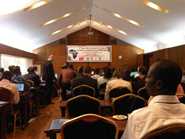CDC Meets With 23 African Countries to Discuss Influenza Surveillance
Inernational Program Highlight
For many years, Africa had few influenza surveillance sites, making it difficult to estimate the burden of influenza in the continent and know the activity level at any given time. To help address this, the CDC has taken a number of important steps towards improving influenza surveillance in Africa. Since 2005, CDC’s Influenza Division has established cooperative agreements in 13 African countries. These cooperative agreements are intended to enhance laboratory diagnostic capacity and surveillance for influenza, strengthen pandemic and outbreak response capabilities and make influenza reporting routine for African countries. Also, CDC’s field staff offer technical assistance for influenza activities throughout Africa.
January 11-12, 2011, the African Network for Influenza Surveillance and Epidemiology (ANISE) had its second annual meeting in Accra, Ghana. The meeting was co-hosted by CDC, the Noguchi Memorial Institute for Medical Research, and Naval Medical Research Unit No. 3 (NAMRU-3). It brought together approximately 100 members from 23 African countries, along with representatives from Ghana Health Services, World Health Organization (WHO), Agence de Medecine Preventive (AMP), and Institut Pasteur.
Attendees discussed influenza surveillance and research projects that they had conducted over the past two years. Highlights of the meeting included brief presentations given by each country showcasing their surveillance achievements and epidemiologic and laboratory data. In addition, scientists presented posters on influenza research studies and projects in Africa. Future projects of the ANISE group that were proposed at the meeting included publishing a summary of 50 years of African influenza surveillance data, as well as giving each country the opportunity to publish its data in a 2011 issue of the Journal of Infectious Disease.

Seminar session during 2011 ANISE meeting; photo by Richard Davis.
ANISE was founded in 2009 to help scientists share and standardize influenza surveillance methods in Africa. ANISE encourages African countries to generate and disseminate data on the burden and epidemiology of influenza. Members can use the Network to coordinate with one another and provide laboratory and epidemiologic support to other members. The Network is open to all individuals working on projects or research related to influenza in Africa. Currently, ANISE has approximately 200 members. As one of the founding members of ANISE, the Influenza Division at CDC publishes a quarterly newsletter for the Network. CDC also maintains an ANISE listserv and blackboard site.
In addition to its role in ANISE and the maintenance of 13 cooperative agreements with countries in Africa, CDC is playing other important roles with regard to influenza surveillance activities in Africa. CDC’s Influenza Division and the Global Disease Detection group have provided five training sessions every year on topics such as influenza sentinel site surveillance, influenza laboratory methods, and pandemic rapid response, which have resulted in over 500 people in 32 African countries receiving influenza training. The impact of this training and technical assistance is reflected in the increased number of respiratory samples submitted to the WHO: in 2009, over 1,200 specimens were sent to WHO Collaborating Centers, compared to fewer than 200 specimens sent in 2004.
The third annual ANISE meeting will be held in Kenya in 2012.
Special thanks to the CDC Influenza Division's Jennifer Michalove and Richard Davis in writing this article.
- Page last reviewed: August 16, 2011
- Page last updated: August 16, 2011
- Content source:
- Centers for Disease Control and Prevention
- Page maintained by: Office of Associate Director of Communication, Division of Public Affairs


 ShareCompartir
ShareCompartir